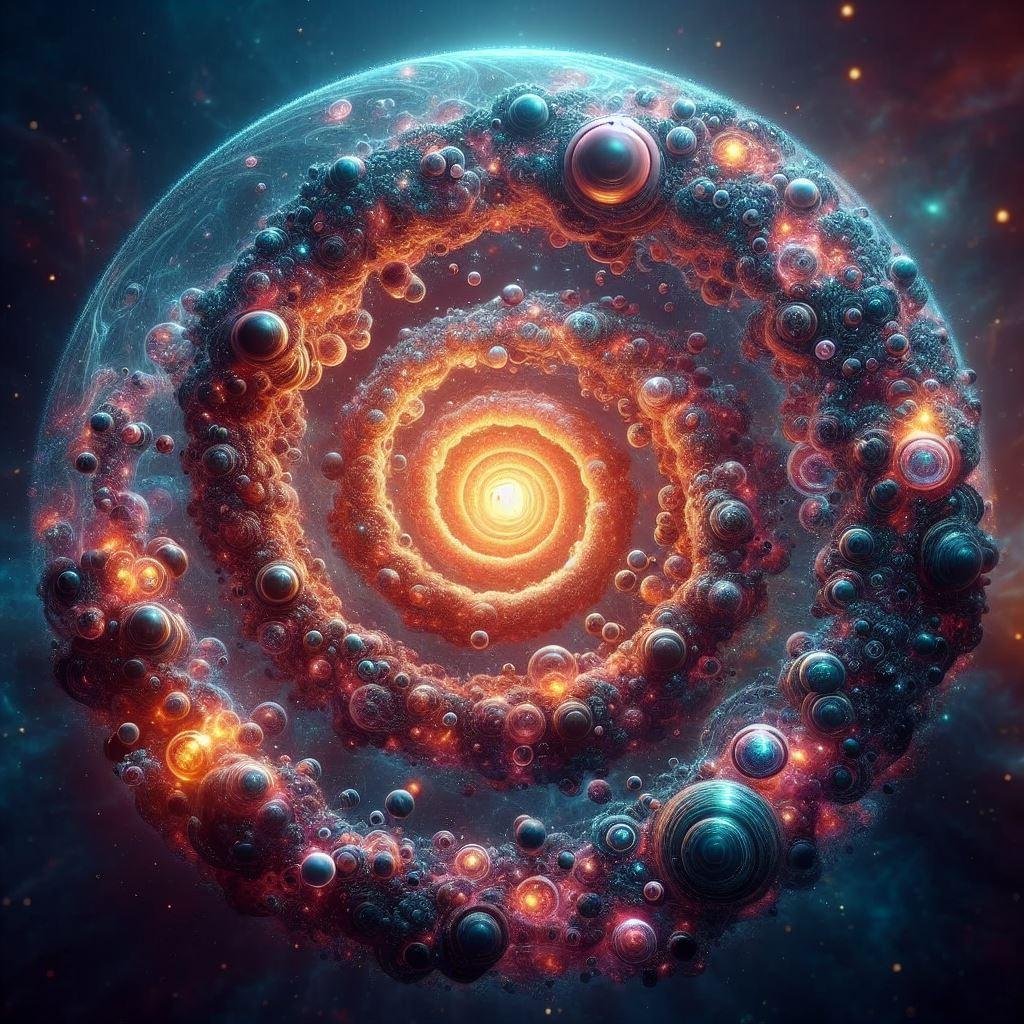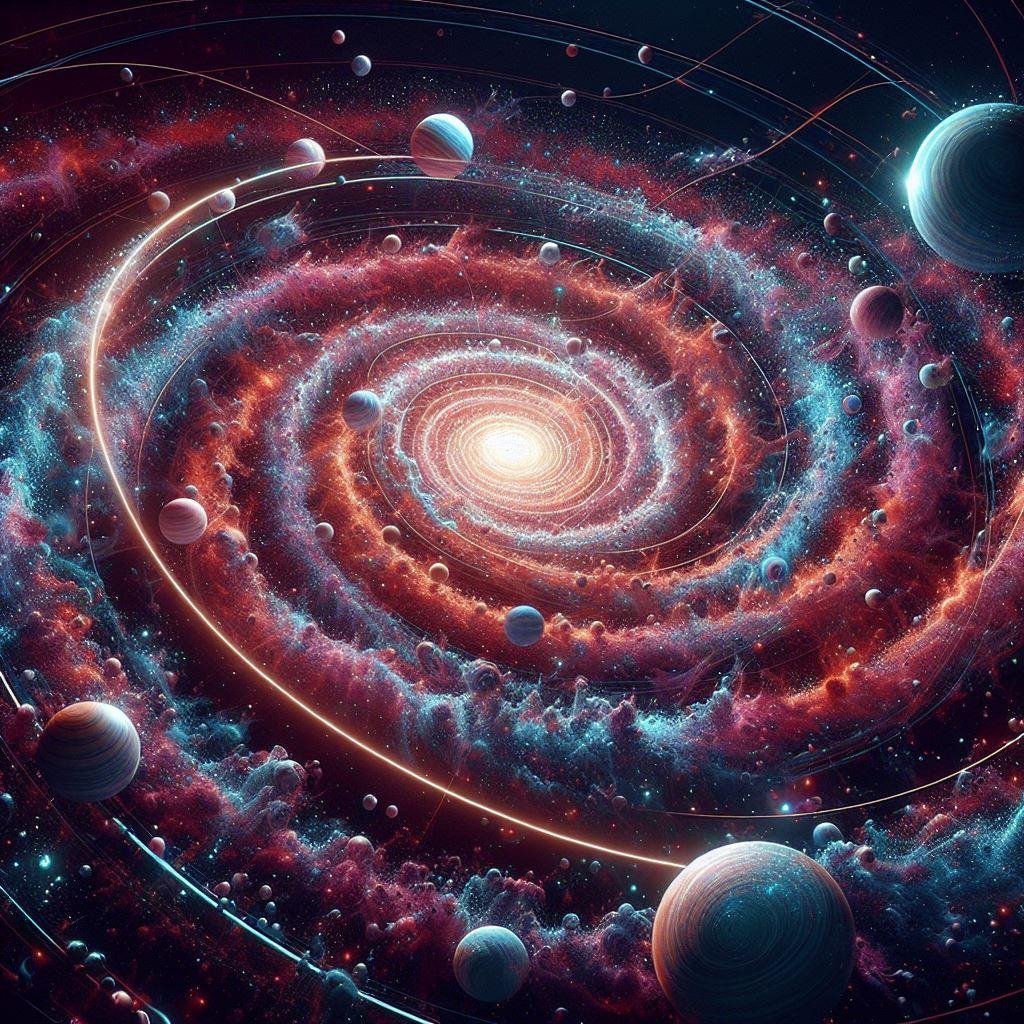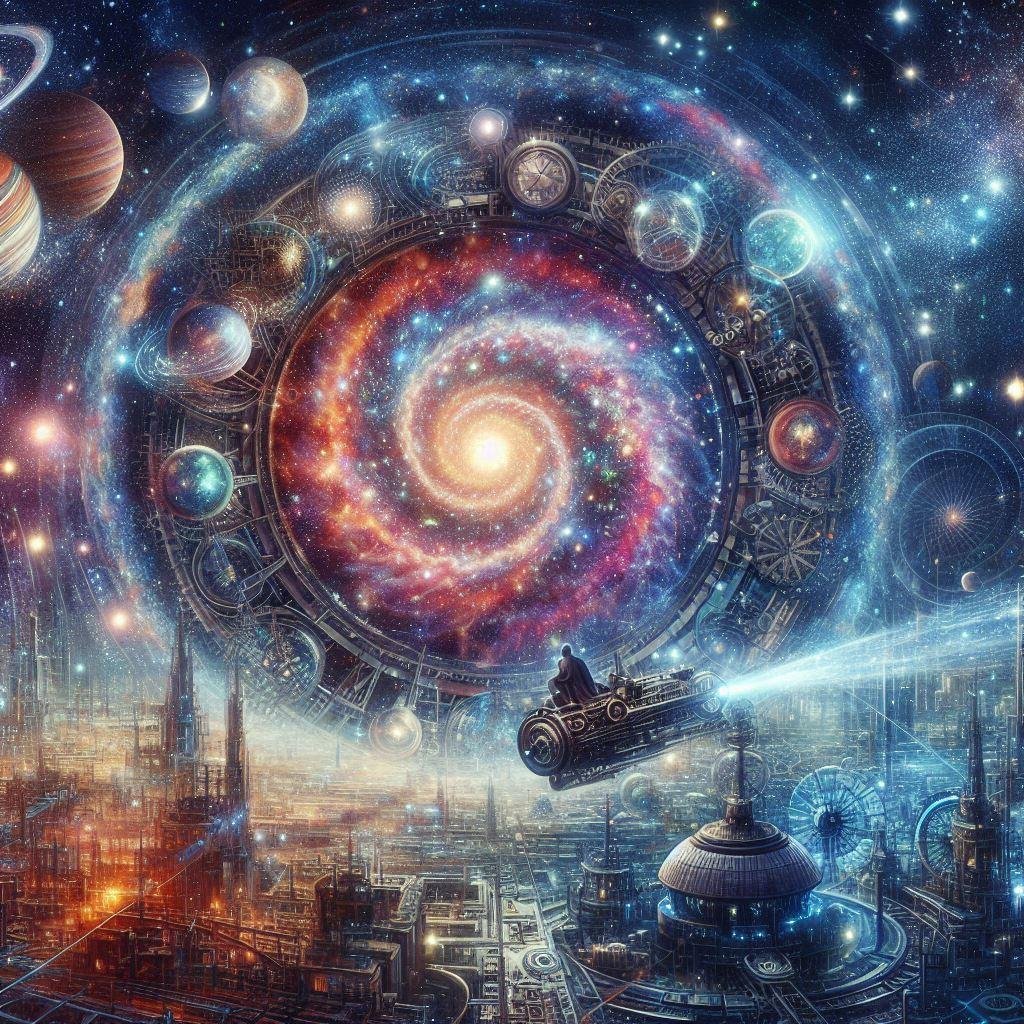Galaxies Theory:
The theory of galaxies, as we understand it today, originates from centuries of observations, theoretical advancements, and technological developments in astronomy. Here’s a brief overview of the development of the theory of galaxies:
- Pre-Modern Views: In ancient times, humans observed stars and celestial objects in the night sky. Early civilizations developed various mythologies and cosmologies to explain these observations, often attributing celestial phenomena to the actions of gods or mythical beings.
- Early Observations: With the advent of telescopes in the 17th century, astronomers began to make more detailed observations of the night sky. Galileo Galilei made some of the earliest telescopic observations of celestial objects, including the Moon, planets, and stars.
- Island Universes: In the 18th and 19th centuries, astronomers began to debate the nature of “nebulae,” fuzzy patches of light observed in the sky. Some astronomers, such as William Herschel, proposed that these nebulae were distant “island universes” or galaxies similar to our Milky Way, consisting of stars and other celestial objects.
- The Milky Way as a Galaxy: By the early 20th century, astronomers had established that our Milky Way galaxy was just one of many similar systems in the universe. Observations by Edwin Hubble and others showed that some of the “spiral nebulae” previously thought to be part of the Milky Way were actually separate galaxies located far beyond our own.
- Modern Understanding: In the mid-20th century, advancements in observational techniques, such as radio astronomy and space-based telescopes, provided new insights into the structure and dynamics of galaxies. The development of theoretical models, such as the Big Bang theory and cosmological simulations, helped to refine our understanding of how galaxies form, evolve, and interact with each other over cosmic time.
Today, the theory of galaxies is a cornerstone of modern astrophysics and cosmology. It encompasses a wide range of topics, including galaxy morphology, stellar populations, dark matter, galaxy formation and evolution, galactic dynamics, and the large-scale structure of the universe. Ongoing observations and theoretical research continue to deepen our understanding of galaxies and their role in the cosmos.

Galaxies Theory:
The theory of galaxies, as it pertains to the study of the universe and its structures, shares natural similarities with various phenomena and principles in physics, astronomy, and cosmology. Here are some of the natural similarities:
- Gravitational Dynamics: Galaxies are bound systems of stars, gas, dust, and dark matter, held together by gravitational forces. The study of galaxy dynamics, including the motion of stars within galaxies and the interactions between galaxies, is governed by principles of gravitational physics, such as Newton’s laws of motion and the law of universal gravitation.
- Cosmological Expansion: Observations have revealed that the universe is expanding, with galaxies moving away from each other as space itself expands. This phenomenon, known as cosmological expansion, is described by Einstein’s theory of general relativity. The study of galaxies provides crucial insights into the expansion rate of the universe and the large-scale structure of cosmic space.
- Dark Matter: Observations of galaxy rotation curves and gravitational lensing suggest the presence of vast amounts of unseen matter known as dark matter, which exerts gravitational influence on galaxies and the universe as a whole. The nature of dark matter remains one of the most significant mysteries in modern astrophysics.
- Galactic Evolution: Like organisms, galaxies evolve over time, undergoing processes such as star formation, mergers with other galaxies, and interactions with their environment. The study of galaxy evolution draws analogies with evolutionary biology, as astronomers seek to understand the origins and development of different galaxy types and structures.
- Cosmic Microwave Background Radiation: The cosmic microwave background (CMB) radiation is the remnant heat from the Big Bang and provides a snapshot of the early universe when it became transparent to radiation. Observations of the CMB help constrain theories of galaxy formation and the evolution of cosmic structure.
- Stellar Processes: Within galaxies, stars undergo various processes, such as nuclear fusion, stellar evolution, and supernova explosions. These stellar processes influence the chemical enrichment of galaxies, the formation of new stars, and the production of heavy elements essential for life.
- Black Holes: Many galaxies harbor supermassive black holes at their centers, which can profoundly affect the dynamics and evolution of their host galaxies. The study of black holes within galaxies provides insights into the connections between galaxy growth, star formation, and the accretion of matter onto black holes.
Overall, the study of galaxies offers a rich tapestry of natural similarities with fundamental principles in physics, astronomy, and cosmology, providing insights into the nature and evolution of the universe on both cosmic and microscopic scales.

Galaxies Theory:
While the theory of galaxies itself primarily focuses on the structure, formation, and dynamics of galaxies in the universe, it indirectly relates to life in several ways:
- Cosmic Environment: The formation and evolution of galaxies shape the cosmic environment in which life exists. Galaxies provide the building blocks for stars, planets, and the chemical elements necessary for life as we know it. The evolution of galaxies influences the availability of heavy elements essential for life, such as carbon, oxygen, and nitrogen, through processes like stellar nucleosynthesis and supernova explosions.
- Galactic Habitable Zones: Within galaxies, certain regions known as galactic habitable zones are conducive to the formation and sustainability of life. These regions typically lie within spiral arms where the density of gas and dust is higher, promoting the formation of stars and planetary systems. The study of galactic habitable zones helps astronomers identify potential targets in the search for extraterrestrial life.
- Impact of Galactic Events: Galactic events such as supernovae, gamma-ray bursts, and galactic collisions can have profound effects on planetary systems within galaxies. These events can influence factors such as atmospheric composition, radiation levels, and climate on planets, potentially impacting the conditions for life. Understanding the frequency and effects of such events can inform our understanding of the habitability of galaxies.
- Cosmic Evolution and Life’s Origins: The study of galaxy evolution and cosmic history provides insights into the conditions that led to the emergence of life in the universe. By tracing the evolution of galaxies over cosmic time, astronomers can infer the prevalence of habitable environments and the likelihood of life arising on planets within those galaxies. Understanding the cosmic context in which life emerged can shed light on the processes that govern life’s origins and evolution.
While the theory of galaxies may not directly address the existence or characteristics of life, it provides a broader cosmological framework within which life arises and evolves. By studying galaxies and their evolution, scientists gain insights into the cosmic environment that shapes the conditions for life in the universe.

Galaxies Theory:
The theory of galaxies as distinct systems separate from our own Milky Way galaxy didn’t have a single inventor, but rather emerged gradually over time through observations, theoretical developments, and advances in technology. However, several key figures contributed significantly to the understanding of galaxies:
- William Herschel: In the late 18th century, William Herschel, a German-born British astronomer, made extensive observations of the night sky using powerful telescopes of his own design. He cataloged thousands of nebulae, including many galaxies, and proposed that some of these nebulae might be “island universes” similar to our Milky Way.
- Edwin Hubble: In the early 20th century, Edwin Hubble, an American astronomer, made groundbreaking observations that confirmed the extragalactic nature of certain nebulae. Using the newly constructed Hooker Telescope at Mount Wilson Observatory, Hubble discovered Cepheid variable stars in the Andromeda Nebula (now known as the Andromeda Galaxy). By measuring the distances to these stars, he demonstrated that the Andromeda Nebula was far beyond the bounds of our Milky Way, establishing it as a separate galaxy. Hubble’s work provided evidence for the existence of other galaxies beyond our own and laid the foundation for modern extragalactic astronomy.
- Harlow Shapley: Another influential figure in early extragalactic astronomy was Harlow Shapley, an American astronomer. In the early 20th century, Shapley conducted studies of globular clusters in our Milky Way and used their distribution to estimate the size and structure of our galaxy. His work helped to establish the vast scale of the universe and the existence of other galaxies beyond the Milky Way.
- Vesto Melvin Slipher: Slipher, an American astronomer, played a crucial role in the early study of galaxies through his spectroscopic observations. In the early 20th century, Slipher observed the spectra of several spiral nebulae (now known as spiral galaxies) and found that many of them exhibited redshifts, indicating that they were moving away from Earth. Slipher’s work provided early evidence for the expansion of the universe and the cosmological implications of galaxy motion.
These astronomers, among others, contributed to the development of the theory of galaxies as distinct systems separate from our own Milky Way. Their observations and discoveries reshaped our understanding of the universe and laid the groundwork for modern extragalactic astronomy.

Galaxies Theory:
The theory of galaxies, which encompasses our understanding of the structure, formation, and evolution of galaxies in the universe, has numerous practical applications and implications across various fields of science and technology. Here are several ways in which humans can use the theory of galaxies:
- Cosmology and Fundamental Physics: The study of galaxies provides crucial insights into the fundamental properties and dynamics of the universe. By observing the distribution of galaxies on large scales and measuring their motions, astronomers can test theories of cosmology, such as the Big Bang model and the nature of dark matter and dark energy. Understanding the large-scale structure of the universe helps to uncover its origins, evolution, and ultimate fate.
- Galactic Archaeology: Galaxies preserve a record of their formation and evolution in their stars, gas, and chemical elements. By studying the ages, compositions, and orbits of stars within galaxies, astronomers can reconstruct the history of galaxy formation and uncover clues about the processes that shaped them over cosmic time. This field of research, known as galactic archaeology, provides insights into the formation of structures in the universe.
- Exoplanet Detection and Characterization: Galaxies contain numerous stars, many of which host planetary systems. By studying the properties and distribution of stars within galaxies, astronomers can infer the prevalence and diversity of planetary systems in the universe. This information informs efforts to detect and characterize exoplanets orbiting stars both within our galaxy and in distant galaxies.
- Gravitational Lensing: Galaxies can act as gravitational lenses, bending and distorting the light from background objects behind them. This phenomenon, known as gravitational lensing, provides a powerful tool for studying the mass distribution of galaxies and galaxy clusters, including the distribution of dark matter. Gravitational lensing also magnifies distant objects, allowing astronomers to observe faint and distant galaxies that would otherwise be undetectable.
- Formation and Evolution of Cosmic Structures: The theory of galaxies helps us understand how structures form and evolve in the universe, from individual galaxies to galaxy clusters and superclusters. By simulating the formation and evolution of galaxies within the framework of cosmological models, scientists can test theories of structure formation and compare theoretical predictions with observational data. This research sheds light on the processes driving the growth and evolution of cosmic structures.
- Technological Innovation: The study of galaxies drives technological advancements in observational astronomy, data analysis techniques, and computational modeling. Technologies developed for observing galaxies, such as telescopes, detectors, and imaging systems, often find applications in other fields, including medical imaging, remote sensing, and communications technology.
Overall, the theory of galaxies serves as a foundation for understanding the universe and has far-reaching implications for science, technology, and our broader understanding of the cosmos.

The theory of galaxies intersects with advanced civilizations in several ways, particularly in the context of scientific advancement, technological innovation, and cultural exploration. Here are some points where the theory of galaxies aligns with the peaks of human civilization:
- Scientific Inquiry and Exploration: The development of the theory of galaxies reflects humanity’s curiosity about the cosmos and our relentless pursuit of knowledge. Advanced civilizations have historically shown a deep interest in understanding the nature of celestial objects, including galaxies, through observation, experimentation, and theoretical analysis. The study of galaxies represents a pinnacle of scientific inquiry, requiring sophisticated observational techniques, mathematical modeling, and interdisciplinary collaboration.
- Technological Advancement: The study of galaxies drives technological innovation and pushes the boundaries of what is technologically achievable. Advanced civilizations develop increasingly powerful telescopes, detectors, and computational tools to observe, analyze, and simulate galaxies. Technologies developed for studying galaxies often have broader applications beyond astronomy, contributing to advancements in fields such as optics, data processing, and materials science.
- Cultural and Philosophical Reflection: The theory of galaxies has profound cultural and philosophical implications, shaping our understanding of humanity’s place in the universe. Advanced civilizations contemplate the vastness of space, the origins of galaxies, and the possibility of life beyond Earth. The study of galaxies inspires awe, wonder, and existential reflection, driving artistic expression, philosophical inquiry, and cultural exploration.
- Cosmic Perspective: The theory of galaxies provides a cosmic perspective that transcends individual cultures and civilizations. Advanced civilizations recognize the interconnectedness of all life forms and the fragility of our planet within the vast expanse of the cosmos. The study of galaxies fosters a sense of global consciousness and environmental stewardship, motivating efforts to protect and preserve our planet for future generations.
- Collaborative Endeavors: The study of galaxies often involves international collaboration and cooperation among diverse communities of scientists, engineers, and researchers. Advanced civilizations recognize the importance of global cooperation in addressing complex scientific challenges and advancing our collective understanding of the universe. Collaborative endeavors in space exploration, astronomy, and cosmology promote cultural exchange, diplomatic relations, and mutual respect among civilizations.
Overall, the theory of galaxies represents a pinnacle of human achievement and intellectual inquiry, reflecting humanity’s innate curiosity, technological ingenuity, and cultural aspirations. Advanced civilizations embrace the study of galaxies as a cornerstone of their scientific, technological, and cultural endeavors, fostering collaboration, innovation, and exploration on a cosmic scale.

Galaxies began to form relatively soon after the Big Bang, which occurred approximately 13.8 billion years ago. The precise timing of galaxy formation and the mechanisms involved are complex and still the subject of ongoing research. However, astronomers have developed several theories and models to explain how galaxies formed over cosmic time. Here’s an overview of the main theories:
- Hierarchical Structure Formation: One of the prevailing theories of galaxy formation is based on the hierarchical growth of structure in the universe. According to this model, small fluctuations in the density of matter in the early universe led to the formation of dark matter halos, which gravitationally attracted gas and dust. Over time, these halos merged and accreted additional matter, eventually forming galaxies. Smaller galaxies merged to form larger galaxies, leading to the hierarchical growth observed in the distribution of galaxies today.
- Cold Dark Matter Model: The cold dark matter (CDM) model is a specific version of the hierarchical structure formation theory that incorporates the influence of dark matter, a mysterious form of matter that does not emit or interact with light but exerts gravitational influence. In the CDM model, dark matter plays a central role in galaxy formation by providing the gravitational scaffolding around which ordinary matter accumulates and forms galaxies.
- Galactic Winds and Feedback: Another important aspect of galaxy formation is the role of galactic winds and feedback processes. As galaxies form and evolve, the intense radiation and supernova explosions from massive stars can drive powerful winds that expel gas and dust from the galaxy. This feedback process regulates star formation and can influence the size, shape, and chemical composition of galaxies over time.
- Galactic Mergers and Interactions: Galactic mergers and interactions also play a significant role in shaping galaxies. When galaxies collide or interact gravitationally, their gas, stars, and dark matter can be disrupted, triggering bursts of star formation, the formation of new structures such as spiral arms or tidal tails, and the growth of supermassive black holes at the centers of galaxies.
- Early Galaxy Formation: The earliest galaxies in the universe, known as “primordial galaxies,” likely formed within a few hundred million years after the Big Bang. These primordial galaxies were small, irregularly shaped systems composed primarily of hydrogen and helium gas, with relatively few heavy elements. Observations from telescopes such as the Hubble Space Telescope and the James Webb Space Telescope provide valuable insights into the formation and evolution of early galaxies.
In summary, galaxies began to form billions of years ago through a combination of gravitational collapse, hierarchical growth, feedback processes, and interactions between galaxies. Understanding the details of galaxy formation remains an active area of research in astronomy and cosmology, with astronomers using advanced telescopes, computer simulations, and theoretical models to unravel the mysteries of the cosmic past.
Read More Interesting Story:
https://dotparks.com/football-game/
https://dotparks.com/transformers/
https://dotparks.com/ludo-game/
https://dotparks.com/capacitor/
https://dotparks.com/what-is-transistor/
https://dotparks.com/zener-diode-in-mobile-motherboard/
https://dotparks.com/ants-community/

